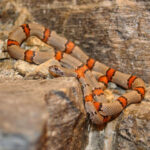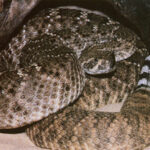Perhaps you are looking into buying a garter snake, or have recently acquired one, but are unsure of their characteristics and needs. This article will serve as a basic care guide for beginner garter snake owners. All information in this care guide is relevant for a store bought garter snake. The care requirements of wild-caught garter snakes vary greatly, and I highly discourage anyone from attempting to domesticate a wild snake.
Selecting your snake
If you have not yet purchased your corn snake, there are a few things you should check for before choosing one:
1. What is its activity level in the cage? Is it active, or is it lying around, sluggish, and dull looking? Keep in mind that if it’s not moving, it may be sleeping. Ensure that it is awake before moving on. The snake should be active and alert. If it is not, and no outward signs of illness are visible, than it likely has an internal disease.
2. What is the physical condition of the snakes’ body? Does it have any scars, missing scales, lumps, open sores, oozing, or bruised spots? If so, it is ill and should not be bought. DO NOT purchase a sick snake out of pity in hopes of nursing it back to health. It can be extremely expensive, and usually the snake is already beyond help.
3. Carefully examine its body for mites. These will be tiny, almost invisible red specks that will be crawling over the scales. You should not purchase a parasite infested snake.
4. Ask about the snakes’ diet, and how often it has eaten. Some stores will purposely starve a snake to keep it smaller.
If the snake demonstrates none of these, more than likely it is in good health and safe to purchase.
Housing your snake
Garter snakes grow a maximum of three feet long, so they do not require a very large cage. A 10 gallon aquarium will easily house your garter snake for awhile, though it is probably best to get a 20 gallon and avoid having to switch cages later on; a 20 gallon tank will also give the snake adequate exercise room.
Garter snakes, like other snakes, require a hide box. Because they are so small and abundant, most every creature is a predator to them. However, a hiding spot for a garter snake can simply be a thick plant for it to hide in.
Another thing necessary to every cage is substrate, which is a substance put on the bottom to make the cage easy to clean when the snake defecates. Butcher paper, newspaper, Astroturf, or snake bedding available in pet stores are all options. Newspaper is the easiest to clean, but the most unattractive. Astroturf looks best, but has to be removed every time it requires cleaning, and you will have to have a spare piece to put in its place. What you use is simply a matter of how much work you want.
Garter snakes definitely need something to climb on. Wedging a large branch with a couple smaller ones diagonally across the cage is best. Be sure the branch is wedged snugly so it doesn’t fall on your snake.
Lastly, there is lighting and heating. Heating is essential because snakes are cold-blooded creatures. Avoid heating rocks completely, as they are dangerous to a snake, causing thermo burns and possibly even electric shock. I recommend under-tank heating pads. They are simple and work very well. Place the heating pad under 1/3 of the cage on either the right or left side. You can also get a large flat stone, and shine an incandescent lamp [40 to 60 watt bulb] on it from the top of the cage. The snake will bask in the heat when necessary. Note that a heating pad may still be necessary.
Since garter snakes come from all corners of the US, they have a great resistance to a wide range of temperatures. The cage can be kept at room temperature, just make sure that a heating pad is available for them to warm up on, and a large water dish for them to cool down in. With this is mind, know that garter snakes like to get in water, but they do not like to live in it. Make sure that your cage does not become damp, or the snake with become stressed and ill.
Unless the snake is in a windowless room, natural light will be fine; no artificial lighting is necessary, though certain lamps may accentuate your snakes colors.
Feeding your snake
All snakes are carnivores and eat meat. Garter snakes eat amphibians, worms, and fish. Because of their activity level, garters eat very frequently, usually once a day. Because of this, they defecate frequently and their cage is always requiring cleaning.
You can feed your snake earthworms. While earthworms make a good meal, they are not completely nutritious. About every two weeks you will need to roll the worm in a powered vitamin mix to prevent it from getting a B1 deficiency. Don’t do this any more than twice a month, however, or they will become overdosed.
It is best to feed your garter whole fish instead of fillet pieces, because whole fish are more nutritious. Also, the garter may refuse fillet pieces because it does not resemble food.
Food can be given alive or dead; either way they should be placed in a dish so the snake does not ingest the substrate. Fish can be placed in the snakes’ water bowl. Note that some garters will refuse food that is not alive. The best remedy for this is to place live fish in its water dish. They can be purchased relatively cheap at a pet store, and kept in a small aquarium. Be sure the fish are not any larger than 2 and a half times the size of your snakes head.
A note about collecting food outdoors: collecting food outdoors can be both a hazard to your pet and possibly illegal, depending on where you live and what you collect. If you collect earthworms and fish outdoors, be sure they come from an area where no pesticides could have been sprayed, no contaminates have reached the grounds, and nothing has flowed downstream into the water.
Be sure to give your snake time to digest its meal before handling it, less it regurgitate on you.
Handling
Have you ever held a snake? It is probably a wise choice to hold a snake at least once before purchasing one. Garter snakes are little creatures of energy, always moving; after they deduce that you are not a threat, they will readily welcome your warm touch and prove to be hours of fun. However, if you do not frequently handle your snake, it may become aggressive when held. It is important for your snake to become familiar and comfortable when held.
When you pick a snake up, ALWAYS make sure it has seen you first. Never sneak up on a snake, you will surprise it and it will bite you! Look at it through the cage first; make sure it has seen you. Then touch it a little before grasping it gently in the center of its body. Wrap your fingers under its belly and rest your thumb gently on its back. The center of the body must be supported, because it is heaviest. Put your other hand between its head and the hand you are grasping the center of the snake with. Be careful not to smack its head when removing it from the cage. If the snake is small, however, you can grasp it with one hand. If the snake is comfortable with you, you could even put your hand in the cage and allow it to crawl on itself.
Allow the snake to glide between your fingers if it’s a smaller sized snake; if it is a larger snake, allow if to glide over your arms. Change its direction with a guiding hand, never forcefully.
Snakes seem to have a thing for shirts. Do not panic if your garter goes up your sleeve, and certainly do not run around screaming, as this will panic the snake and it will either bite or constrict in an attempt not to fall. Also, you may step on it if it does fall to the ground. Simply reach in and grasp it gently, or take your shirt off, which ever works best.
After your snake becomes comfortable with you, it will likely wrap itself around your arm or between your fingers and promptly go to sleep, where it can be happy for hours.
Lastly, DO NOT CHASE PEOPLE WITH YOUR SNAKE! Never, ever run with the snake, especially chasing people with it. They will likely scream and even smack at it, which will throw your snake into a panic and possible cause it to bite. It will also put great stress on your snake, which will in turn lead to illness.
There you have it! The basics of garter snake ownership. You are now equipped with the knowledge to adequately care for your garter snake. Remember that this is general info. If you seek more specific knowledge in a certain area, contact a vet that specializes in reptiles, or your local herps society.





